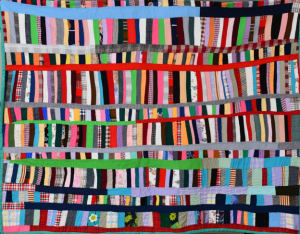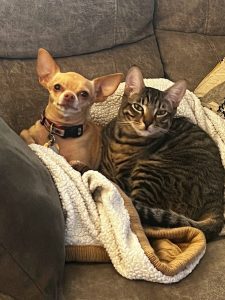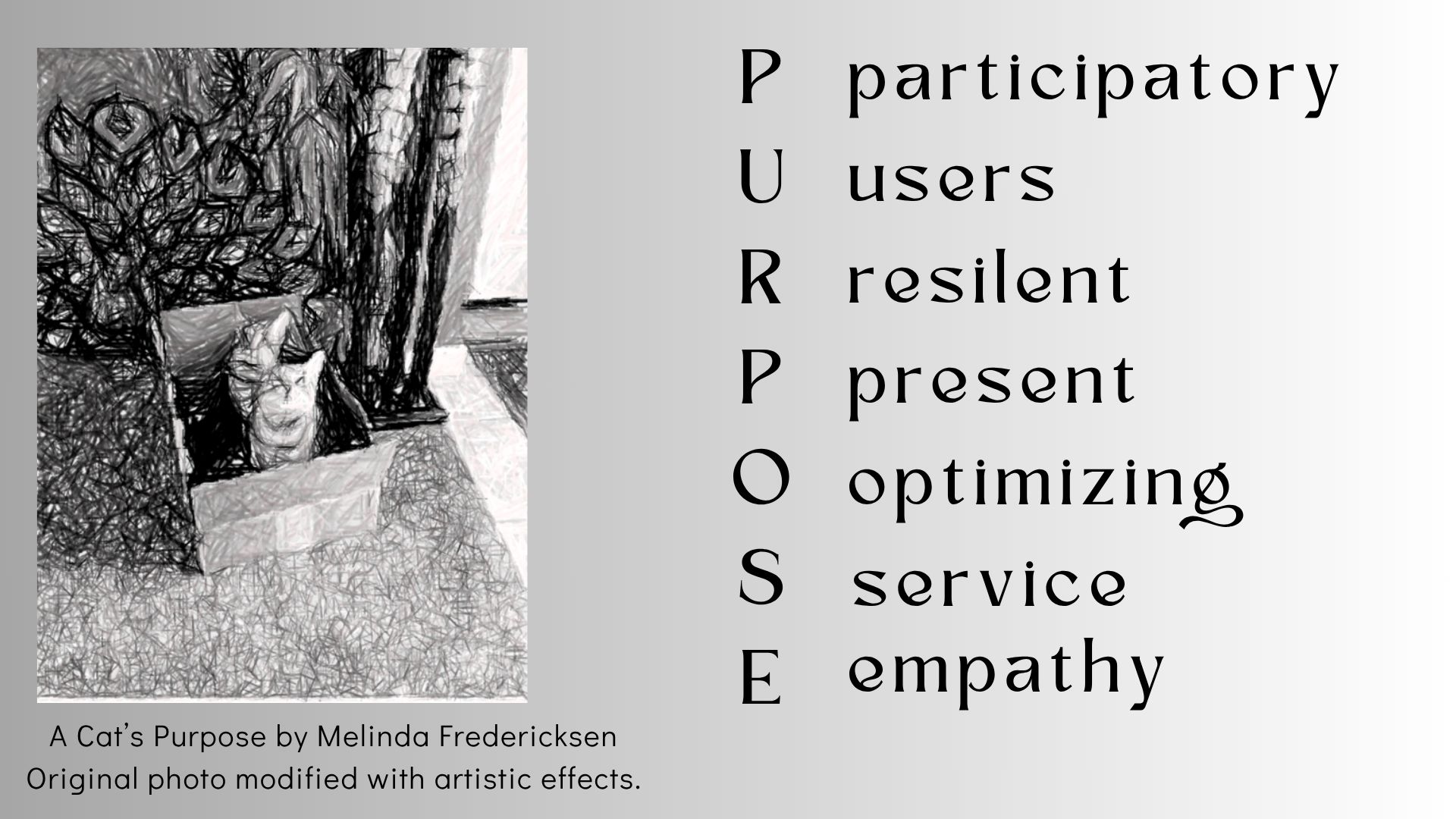Hyperlinked Communities – The Strength of Quilted Fabrics
Communities have been conceptualized as fabrics with libraries interwoven into the overall piece. Communities can also be perceived by community members as closed systems, wherein information restrictions exist for subgroups, prioritization directed towards “traditional” members and minimization of outside or “other” influences.” Weaving fabrics is deliberate and requires forethought to the strength of the individual threads, rate of decay of natural fibers and aesthetic. The analogy that may provide a more complex summarization is the patchwork quilt. A quilt is composed of three primary layers: top, insulating middle and the bottom or backing. Depending on the intent, perfect monotone patterns can be generated. Below, Mabel Williams improvised a quilt consisting of multiple fabrics, colors, and age of materials. On the top layer each piece is stitched to similar sized pieces and once the desired length has been achieved. Once the pattern of the top layer has been completed it is bonded to the middle and backing layers with a stitch that intersects all three layers. What once was a scrap piece before now is joined into a larger mosaic, multilayered and capable of providing comfort.

Mabel Williams, Improvisational Strip Quilt, 1968. cotton, polyester, wool, and twill hand quilted and hand pieced. Photo courtesy of the Mississippi Museum of Art. https://www.msmuseumart.org/wp-content/uploads/2023/02/35-scaled.jpg
Tangentially, the strength of a quilt is determined similarly to the strength of a reading culture. No one layer, no one thread carries the entire burden. Literacy capabilities have been in crises in California for decades and in my resident county, it is a well-known epidemic with seemingly no resolution. Lauersen (2025) libraries as our largest cultural institutions, that regardless of country identification have been decreasing in visitor attendance and therefore transmission of tangible and intangible cultural heritage. A significant portion of our reading from what I have gathered over the past few weeks has been focused on the larger, conducive picture of what can be achievable if we view our communities not as closed systems composed of minute, identifiable open systems but as complex systems. My greater community has an issue with literacy for both children and adults, with the awareness that most people within our community have not progressed past a third grade reading level. The National Center for Education Statistics estimate that 28% of Californians fall below the third-grade average and that statistically their children will have a 72% likelihood of not perpetuating a reading culture (Lucas, 2024).
A possible solution is utilizing bookmobiles. Libraries in other municipalities have adapted, continued, or returned to a tradition of a mobile library: bringing books to the people instead of people to the physical institution (Lauresen, 2025). In casual conversation with friends, acquaintances, and people in a variety of ques libraries at elementary schools are either limited in physical space, feature outdated material or are being run by support staff overseen by a principal or other administrator. Even recent EDJOIN postings are for individuals to perform librarian duties without the experience, knowledge, or adherence to the right to read principles. If the demarcation point of literacy is the third grade, we should be providing greater effort to this period of development via innovative methods. Public libraries can collaborate with public schools to expand their holdings and bring a degree of information literacy to the children. This is not in replacement of school libraries, but a stop gap measure to support literacy and another important cultural institution critical to society: the public school.
References
Lauersen, C. (2025, February 5). The necessary nearness – an ode to bookmobiles. Christian Lauersen. https://christianlauersen.net/2025/02/05/the-necessary-nearness-and-ode-to-bookmobiles/
Lucas, G. (2024). Report to the legislature on the California library literacy and English acquisition services program of the California State Library. https://www.library.ca.gov/uploads/2024/06/2024-CLLS-Report-to-Legislature.pdf
Assignment X: Participatory Culture Can Save Libraries
Background Knowledge…about my hometown community
A confession needs to be made – I have long desired to be a librarian but had accepted the belief that libraries were institutions, in my home community at least, on the way to becoming artifacts of a passing age. In 2001 I graduated high school and witnessed local efforts to eliminate funding for libraries because the internet was more readily available. This argument in favor of their funding cuts and space closures is analogous to efforts to eliminate public transport since cars exist. After having researched my community in depth I have come to realize that we represent an area of California with high illiteracy rates and an average reading ability of a literate third-grader. Even before 2001, illiteracy was rampant and continues to be a concern. If you entered a library during this period from recollection it would be quite spaces with one or two people visible at tables or in the stacks. Fast forward to 2025 the library community has significantly changed, making the physical space a hub of activity, support, and community services.
What changed?
An annual response to change in any local government is funding. While a factor, the greatest influence has been the sowing of a participatory culture. Participatory cultures ask not what their libraries can do for them but what they can do with their libraries. Henry Jenkins (2007) identified five components that define participatory cultures: 1) low barriers to expression and engagement, 2) growth of social connection, 3) support for creativity and sharing, 4) informal mentorships and 5) perceptions of participants that their contributions to the culture matter.
In development…
Participatory cultures in any community, rich or poor, also ask librarians and their staff what they can do. Unfortunately, from observation and casual conversations if you are not a part of the regular library community your opinions and library practices are not being addressed. Outside the physical library space, absent patrons are not receiving messages seeking their participation. Virtual and physical interactions only take us so far if we only post and “leave” or attend to other matters without being present and attending (Stephens, 2016, pp. 41). In my current customer service focused role, while engaging with customers I listen and share how to get resources from the library. State Park passes, Discover and Go along with interlibrary loans are revelations to an unscientific statistic of 99.98% of people. Those attending colleges in the area are not aware of their academic library capabilities offering laptops, research help and writing development. The 2024 SWOT analysis of the community college library indicated that only 10% of the student population utilized library and learning center services (MJC). As integral to scholarship and research, the lack of participatory culture is harming libraries and the communities they serve.
Doom scrolling and “we’ve always done it this way”
Please accept my apologies for the sensational paragraph heading as it was meant to capture your possibly wavering attention. In the words of Mr. Spock, “There are always possibilities” and participatory cultures give those possibilities greater statistical advantage. Now where do we go from here and has the surface been scratched to bring clarity to the fresco of what lies beneath?
The budgets for all libraries feature many of the same financial concerns, often utilizing a copy and paste activity to ensure budget consistency. From our reading for the first half of the semester, an idea has been formulating in my brain. If we embrace the notion of thinking like a startup our library budgets could be revitalized every year to condition for constant change (Mathews, 2012). The reality might be far from the proposal, but it helps move thought patterns away from the limitations that are self-imposed. Before enrolling in iSchool, I began a pathway to elementary teaching but hit many detours. The first being COVID-19 and many others related to the dissonance from instruction to on-the-ground practice. Many teachers, parents and students were displaying trauma mitigation responses and just surviving. It illuminated the issue concerning teacher education and the day-to-day expectations in the classroom. The programs supported innovation, while practice removed quickly any perception that the teachers’ contributions matter. If libraries continue to uphold past practices we continue to feed the monster of apathy, sending unintentional messages learned in primary school performance is expected but participating as a community member regardless of age is not for you.
Stimulating the vagus nerve
Final thoughts on introductory material often require stimulation of the vagus nerve to bolster the brain and stimulate new cognitive pathways in the brain. Often in contemplation of a reflection I find myself not breathing deeply or taking the brain breaks infused with exercise to allow connections to occur. I like to think of my brain breaks, particularly walking the dogs as cognitive improvisation or brainstorming where anything goes. When I have a purpose, whether writing a paper or running errands, it brings clarity. As an emerging information professional, I need to embrace our new purpose as defined by participatory culture: a visible and active member of my communities (Stephens, 2016, pp. 80).
References
Jenkins, H. (2007). Confronting the challenges of participatory culture: Media education for the 21st century (Part One). Digital Kompetanse, 2(1), 23–33. https://doi.org/10.18261/ISSN1891-943X-2007-01-03
MJC. (2024, March 1). Library program review: SWOT analysis design. https://yosemiteccd.sharepoint.com/sites/MJCResearch/Shared%20Documents/Forms/AllItems.aspx?FolderCTID=0x01200013CB6AB0EBE6CC438008796F7F57E72A&id=%2Fsites%2FMJCResearch%2FShared%20Documents%2FProgram%20Review%2F2023%20Program%20Review%2F2023%20Program%20Review%20Submissions%2FLibrary%20%26%20Online%20Education
Mathews, B. (2012). Think Like A Start Up.
Stephens, M. (2016). The Heart of Librarianship: Attentive, Positive, and Purposeful Change
A little bit about me…
Hello Fellow Scholars!
I am really excited to be taking this course as the digital age is here to stay, at least until a powerful solar flare or the magnetic filed flips. Given the scale of personal devices with search engines in the United States, it is necessary to embrace what our patrons will be using and incorporate critical thinking skills when engaged. The further I dive into LIS coursework I find that all aspects of librarianship, including the divisions of academic and public services are intriguing. My undergraduate degree was in geology which is not a single field of study but incorporates and works in cooperation with other sciences (biology, chemistry, physics, history and the humanities). For me LIS is an extension of that early foundation of interconnected knowledge and the need to communicate that knowledge to others in a universal fashion.
This past semester and our current one have been a lesson in resilience as the only stable things in my life right now are course due dates, my dogs meal times and watering my peace lilies. For your viewing pleasure please enjoy a selection of dog and cat photos. My family, including young nephews are fans of the Ghostbusters (1984) – we fully embrace the belief of “dogs and cats living together! mass hysteria!”. A few photos below mimic the film, see if you can identify the scene!




